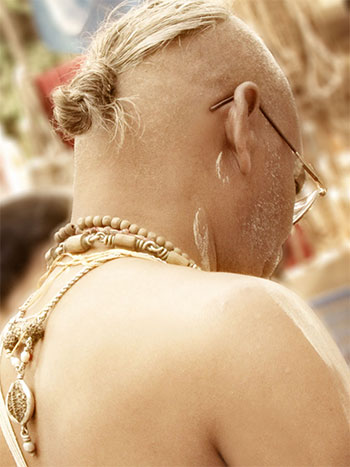
Shikha is a tuft of hair at the back of head specifically kept by Vaishnavas and Brahmanas. According to the Vedic culture, when a person undergoes the cuda-karana-samskara (hair-cutting ceremony) and upanayana (Vedic initiation), he must shave his head, leaving a tuft of hair called a sikha.
It is an established rule that anyone who recites Vedic mantras should not have hair on face and head. So, those who need to perform Vedic rituals are advised to remove their hair.
Our human body has seven energy centres, or chakras, starting from the first at the base of the spine (Mooladhara Chakra) to the seventh and last one – the Sahasrara Chakra. The kundalini is the snake like subtle energy lying coiled at the base chakra, which through yogic exercise can be made to uncoil and rise up through the chakras, finally to the top one, the Sahasrara. The master, one who has achieved the final goal, or enlightenment or perfection or union, is one wherein the kundalini would have reached the Sahasrara chakra.
A Brahmin is one who after all his interim intellectual pursuits, is in ultimate search of this final union or state of perfection. At this point he is said to be one with the Brahman. This is the brahmin’s final goal.
The shika covers that part of the skull wherein lies the final chakra – the Shasrara Chakra. He retains the hair to protect it. Then the question would arise, why shave of the rest of his head?
One of the main rituals of the brahmin’s practice is the Surya Vandana, and Sandya Vandana. It is believed that the sun is the primary source of clean energy not just to the physique, but also to the mind. He wants the uninterrupted rays of the sun to fall on his brain and soak in. (Remember, hair, like our nails, is dead matter.) He stands in the sun three times a day to pray, chant his mantras and meditate – facing the sun.
However, there are many reasons for having Shikha:
1.) When a devotee leaves his body Krishna pulls the soul from the top most chakra which is on the head under the shikha.
2.) It is said that according to the karma of a soul, the living entity at the time of death leaves the body from different places, from mouth, nose, etc… But a devotee who leaves this body from that chakra (sahasrara at the shikha) attains high planets of the Spiritual world.
3.) Also hair is needed to protect that chakra. Women do not cut their hair, because their other lower chakras are not protected well, but if they have long hair they protect them with their hair.
4.) Shikha is also like a spiritual antenna on the top of the head meant to show to the Lord and that we are aspiring recipients of His causeless mercy.
5.) One must have a sikha to perform any kind of yajna. Therefore in Indian tradition all the brahmanas, Vaisnava or otherwise, keep a sikha. Although there seem to be no sastric injunctions regarding the size of the sikha, Gaudiya Vaisnavas traditionally keep the sikha about the size of a calf’s hoofprint, approximately 1.5 inches (5 – 6 cm.) in diameter.
6.) Srila Prabhupada mentioned this in a conversation with some of his disciples in Hawaii (6.5.1972): “Gaudiya Vaishnava shikha is an inch and a half across — no bigger. Bigger shikha means another sampradaya…. And they have to be knotted.”
7.) The shikha may be any length, but it should be kept tightly knotted and only untied when you are washing, The Hari Bhakti Vilasa observes that members of the upper classes even tie the sikha before taking the final ablutions of a bath. This particularly applies when bathing in a body of water such as a river or a lake, in which case to not tie the shikha prior to bathing is considered low class and disrespectful to the sacred rite of bathing.
You may tie it in a simple manner for bathing, retying it more carefully after the bath. Also, when going to sleep, attending funeral rites, or observing a period of mourning, you should keep the shikha untied. Since an untied shikha is a sign of a death in the family, it is inauspicious to go about one’s daily duties with an untied shikha. It is also said that if one keeps the shikha untied, the body may become weak.
While tying your sikha after bathing, chant the Hare Krishna mantra, or, if initiated with Gayatri mantras, silently chant the Brahma-gayatri (first line of Gayatri). The shikha should not be braided (traditionally only women braid their hair), nor should it be kept long and disheveled. Naturally, if the shikha is too short to be tied, it is all right to leave it open, but it should not be disheveled.
8.) Significance of Shaving head – It is a symbol of renunciation. If you see materialists, they are extremely fond of hair. Decorating hair etc pulls us into bodily consciousness. This is not good for practicing spiritualists. So as an indication of renunciation from material consciousness devotees shave head.
9.) Significance of shikha – Another view: It is a symbol of duality of souls and supreme Lord. Impersonalists believe that there is no duality between the supreme and the living entity and they are expected to shave their heads completely. Vaishnavites believe in the philosophy that there is clear and eternal distinction between supreme god Krishna and living entities. The shikha is symbol of Krishna which is large and the remaining very little hair is the symbol of insignificant and innumerable conditioned living entity
10.) Scientific Reasons for Having a Shikha:
(A) A person who keeps Shikha attracts cosmic energy which imparts enlightment.
(B) The small portion of hair that hangs from behind our head applies little pressure on our brains that helps one to improve concentration and mind control and improve memory.
From the time of the Vedas, the shikha was a distinguishing feature of the Brahmins, Kshatriyas and Vaishyas. It signified the ‘twice-born’ or all those Upanayanam has been performed. At the time of Chudakarana, a tuft of hair was left on the head, never to be cut. This shikha covered a large part of the brain. According to Sushruta, the reason that a few tufts are left on the head is that at the crown, an artery joins a critical nerve juncture. Since an injury to this part of the head is believed to be fatal, it was considered necessary to protect the area by keeping a tuft of hair over it. The shikha was a symbol of superiority and of cleanliness.
Any religious or auspicious ceremony required the shikha to be tied in a knot. The knot was tied to the accompaniment of the Gayatri Mantra. An untied shikha was a symbol of disgrace, impurity and mourning.
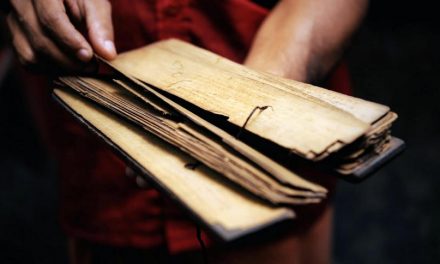
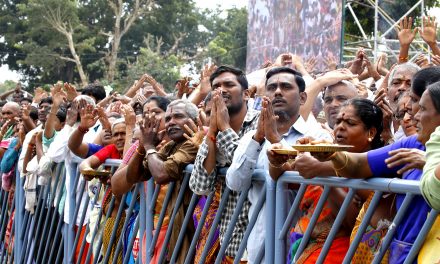
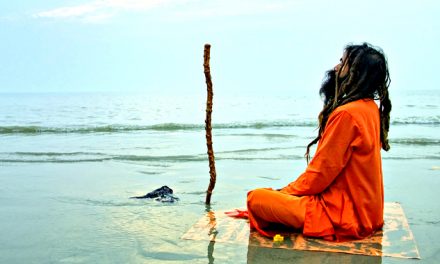
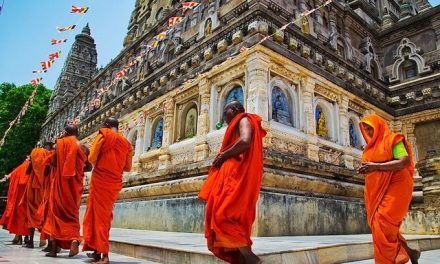









Great informative article. Many people ask me about Shikha all the time. But what of the Vaishnav who’s hair has fallen out and can’t keep a proper Shikha?
This does not make much sense to me, in olden days Rishi Muni’s had long hair tied up nicely symbolising people with Vedic knowledge but in todays world it is opposite. It makes me think this probably changed when shavers where invented.
I believe the middle of head is really soft when baby is born irrespective of male or female. As we grow it seals up and needs to be protected.
Kindly enlighten on the mentioning of Vaishnavas and Brahmins separately in the above article? Thanks
SIKHA is an antenna for transmitting and receiving cosmic energy. All the prayers you perform are transmitted and the cosmic power enters through it.
Such articles help in knowing many Hindu culture based practices which many of us are ignorant. Present day scientific studies have revealed the importance of our ancient practices which were observed by most of us but discorded due to the influence of modern and western culture. Our day to day good practices inherited from our fathers and fore fathers, if proved (is being proved) by scientific studies it will be a big break through and of great significance in leading a good life style, including vegetarian food, fasting on every ‘ekadashi’, yoga and meditation.Slowly we are reverting back to our traditional life style. India has already taught the western world the importance of yoga and meditation. So, let us follow the traditional life style as far as possible and try to know the meaning of several practices followed traditionally.
So nice to read the details of Shikha and it’s significance.
Thanks and Regards
I will never forget Sriman M.K. Krishnamachary, our Sanskrit teacher at Sir M.Ct. Muthiah Chettiar High School who taught thousands of children the basics of Sanskrit. He told us that the tuft that Brahmins wear has not only religious and spiritual significance but, as all our observances, had sensible practical significance. He told us (1941) the tuft is there to protect the MEDULLA OBLONGATA, which is a very, very important part of the Human anatomy.
Krishnamachary was not a highly educated person in scholastic terms, but was a product of the PATASHALA scheme and did not ever need to refer to any test book that we were prescribed, right from Bandarkar’s Grammar. He taught my brother “Kadambari” when he was studying in BA (at our home) and could analyse those page long sentences without ever having to look at the text!
Excellent article which reveals all about ‘shika’ or the ‘kudumi’ we call it in Tamil
The mention that who recite Vedic Mantras and who performs yagnas, should have no hair on their faces and head (except for the tuft of hair) has set me thinking. The present day Vadhyars of the Brahmanas, a miniscule few excepted, do not follow this precept. Those of us who avail their services may be unwittingly transgressing the rules and are denied the benefits of the rituals we perform
The article is really good. We came no know many things. Please keep inform our traditions and their importance. Now a days no body know our traditions and their importance. Please keep inform our traditions.
Pranam. It will be good to give the sources, either after each chapter or at the end of the article. By saying, the ancient said… in hindu texts it is mentioned… Guru x said… is not sufficient to give proper information. Without quotes and sources your articles will only be litterature at best and gossip at worse.
By giving proper information you will be less inclined to lie and by this be more appreciated by God. For example when you say Hindus wear sikhas, NO TRUE, you must say SOME hindus. Sikha is a mark of renunciation. Not true, what about those saddhus with locks and beards ? please be more PRECISE and TRUE if your purpose is to really inform and respect a tradition. (in older days only some selected specialists were allowed to give teachings and information to others)
Sure, Scientifically true. But when one talks of attaining the supreme power so called God, Seven Chakras play a very good role as an indication of maturity level for reunion. In fact, all is for manual reference only. God is Everywhere and everymoment.
An interesting subject, all Hidus should go through.
Basically, all Religions have something to do with Head and Face Hairs.
Muslims Shave their Head and Mustache and keep the Beard.
Buddhists are always supposed to kerp their head Shaved.
Sikhs on the contrary can’t shave their Head, Beard or Mustache throughout their life and they do practice.
Jains are supposed to pluck hair one by one .
Present Generation Hindus ape all other Religion (part or whole), says IT’S FASHION.
This article is generalisation of basic facts, but in actual practice there are clear-cut rituals and meanins associated with those rituals not dealt with in this article. The Chaula-samskaara is described in various Grihya-sutra texts which are part of Vedaanga literature. For instance, Ashvalaayana Grihya Sutra states that Chaulam should be performed either in third year of the child or according to Kuladharma, and then proceeds to describe the various stages and their benefits, ie significance, in the actions performed in Chaulam. Paaraskara-Grihya sutra calls it Choodaakaranam. Basic ritual and procedures in various grihya sutra literature is the same, but there are minor differences. Many Grihya sutras have been translated and commented. Here, it must be remembered that Grihya sutras are for grihasthas. Sanyaasis have different rules to follow. depending on their particular sampradaaya. Even in the Chaulam samskaara, particular deities are associated with various parts of the rituals, and even the knife represents Savitaa, Soma and Varuna. Number of haircuts in Chaula samskaara are also fixed and carry symbolic meanings.
It was interesting to read about Shika orKudumi in Tamil.
While we1re on the subject , I remember reading articles
while going thro Old news papers of early sixties when there was
lot of animosity created by so-called `Revolutionaries` in erswhile
Madras state against Kudimi associating with Brahmins.
The unrests created by Atheist elements was directed against
God , Temples, and Believers and the easy target for them was
Kudimi. But , though in present days , we see only small numbers are seen donning kudimi that too due to professional compulsions, the number of people visiting temples has increased multi fold thus demonstratively negating the atheists ideologies. However, I`ve heard from vedic scholars that to enter the sanctum (karbhagraha) and conduct daily poojas to the deities the pre-requisite is Kudimi.
But to my dismay I find in numerous temples in Karnataka
the Archakas are seldom seen with Kudumi/shika(Excepting Udupi and Manthralaya). Whereas, in contrast we can see kudimi Archakas in most of the temples in Tamilnadu and Andhra.
The Swamijis and Seers should look in to this aspect and insist on kudimi. `
Shika is symbol of bhakthi & devotion
Narayana Sukta: Tasyaaya Shikhaaya Madhye, Parama-atma Vyavasthithaha||
Indiadivine.org is rendering a great service Hindu community by teaching them many lessons of very much importance about their customs and rituals.
Indiadivine .org is rendering a great service to Indians by reminding them of the meaning and purpose of the various customs and rituals they observe in their lives
The Mongols and the Native Americans (who are said to be Mongolian tribes who migrated to the Americas acoss the Bering Strait) also have Shikas or something similar. And Mongolia is considered to be the ancient Utthara Kuru.
Connections? One more mystery to explored!
Thanks for a very valuable information.
This is a very informative article on shilkha. I was all modern until retirement and started sporting shikha, about which I had plenty of attraction and urge to have SINCE THE AGE OF 35- 40 YEARS. At the time of retirement and even a few years before that I had the privilege of coming in contact with Sri Srila Prabhupada’s ISKCON, in connection with translating their english articles to kannada language. During this period, the URGE in me to have a SHIKA WENT UP MANY FOLDS. So I renounced hairs ad sported SHIKHA resisting opposition from my wife and children. That is all old for about ten years now and I now have a neat little shkha(JUTTU as we call it in kannada) ON A NEATLY SHAVED HEAD. Initially I was a bit shy to show it to the world but now nothing like that. BENEFITS?! Benefits are great really It seems the cosmic energy is entering my body ever since I sported shikha. Now I am always enthusiastic, face glowing(TEJAS), have gained double energy in carrying out my work and always active. It has given me an inexplicable satisfaction and happiness and also has cured my six-decade old SINUSITIS TO THE EXTENT OF 95%. In this regard, I request the scientists to take up research work on SHIKHA AND SINUSITIS. I am ready to interact with scientists in this regard. Long live SHIKHA.
Excellent information on Hinduism, Ayurveda etc. Love to read everyday. I am stumped by the class of articles. Is there any scope for me to write articles?
Will you please enlighten me how “Shirdi Sai baba” considered as Hindu saint.